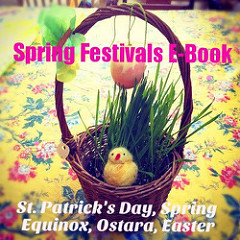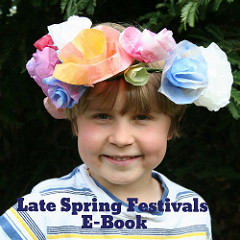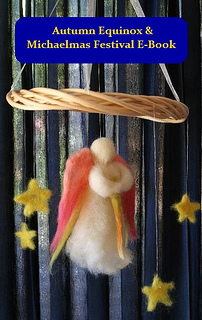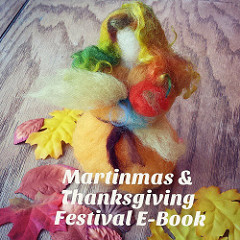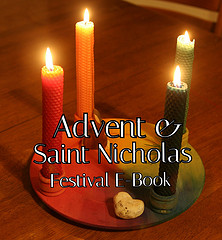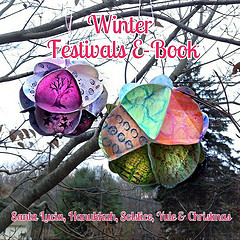Michaelmas
Over the last two weeks, the children in Lucas’s school have been preparing for and celebrating Michaelmas. They’ve heard, watched, and acted out the story of George the farm boy and the dragon. The archangel Michael helps George to overcome the beast who has been ruining the crops.
Lucas has jealously watched while the older children sand, stain, and assemble their own wooden swords. (He will get to make his own next year in Kindergarten.) Mrs. Klocek says he has worked diligently on the classroom swords (3 will stay in the classroom for everyone to play with); he has been fascinated with the project, the object itself, and the work.
I’ve also observed that the story of George, Michael, and the dragon is living in him. He’s been chosen to manipulate the dragon during puppet shows. When I asked what the dragon puppet looked like, he explained that it was a red silk and a green silk knotted together. He has played a cat during their play of the story. His teacher says he’s really into it, attentive, and plays Michael at dress-up time.
I asked Lucas who Michael is. He replied, “An Arch-angel,” with that mom-you’re-so-dumb-you-don’t-know-anything tone of voice. As if that answer settled it. I thought to myself, “Well, sorry, son. I didn’t have a fancy private-school education with mythology, puppets, plays, dragons, and archangels, now did I?”
Last Friday his class celebrated Michaelmas. He brought home a silk cape that they died yellow with marigold petals and a golden crown (like Michael wears). The older children took home their swords. Lucas doesn’t seem too disappointed about not having a sword of his own, which is good because I was a little worried about it (worried both about him having one and not having one).
The significance of this holiday in the Waldorf schools, from what I gather, is that the story of a simple boy who acts out of bravery and righteousness on behalf of others can overcome fear and darkness. That light must be honored and respected, and can be the greatest weapon we possess in the face of frightening challenges. The emphasis in the schools is not placed on killing the dragon (which some fundie Christians take to be a metaphor for pagan/Goddess religion rather than how I see it: a metaphor for fear, hate, bigotry, and isolationism). Rather, in the schools, the children (especially the older children) are taught that we all have within us a dark side, and that we must acknowledge it, learn to control it, and not act out of our destructive emotions. Our dark sides can be a source of strength, inspiration, power, and mystery, but they must be balanced and harnessed by the light for us to live healthy, happy lives and do good in the world.
The youngest children don’t get all that analysis; they just get the story, which lives in them and informs their hearts. It gives them hope as the seasons change and darkness becomes more pervasive and present in their worlds.
EDIT: According to the Sacramento Waldorf School Administrator, Liz Beaven, Michaelmas is this:
“The end of September not only brings glorious autumn weather, it is also a time in the year when day and night stand in balance before we rapidly slide into the long nights of winter. In Waldorf schools throughout the world, at this time of year, communities gather to celebrate the festival of Michaelmas. So it was that we came together last Friday (on the precise day of Michaelmas, September 29th) to face and vanquish a magnificent dragon. Why is this little-known festival celebrated with such enthusiasm and care?
Michaelmas offers us many gifts. It is a celebration of harvest, a focus of agricultural communities at this time of the year. The bounty of the earth is all around us; plants tell us that the expansive days of summer have passed and the quiet mood of winter, when preparations of a new season of growth can occur, will soon be upon us. As a festival, Michaelmas celebrates community, offering an opportunity for us to come together and share fellowship. It is a community gathering: Our athletic field becomes the village green of old.
In addition to these obvious gifts, Michalemas offers a message that is pertinent and highly relevant to our modern condition. Michaelmas speaks of courage, of facing difficult odds, of the triumph of good over evil. It does this through story and symbol. There are two central figures in the story: the dragon and Michael. Unlike its elevated role in many Eastern cultures, in the West the dragon symbolizes our lower selves, the darker forces of nature that are part of our humanity, to challenge and test us. The festival of Michaelmas reminds us that, with heavenly help, we can summon great courage and face our fears and threats. Help is on hand in the form of the Archangel Michael, beloved by children. In this time, maybe more than ever before, we all need reminders of strength, selflessness, courage, hope, and the ultimate triumph of good over evil.
…
It falls to one student, carefully chosen to represent his or her class and the qualities of courage and faith, to stand before the mighty beast, and bid it, in the name of all that is good and true, to submit and lend its power to the forces of good. (Tempting though it is to simply slay the dragon, we do not represent this, for those forces of darkness, of envy, fear, or hatred, are always there to challenge us!)”
Michaelmas, or the Feast of Saints Michael, Gabriel and Raphael is a day in the Christian calendar, taking place on 29 September. Because it falls near the equinox, it is associated with the beginning of Autumn and the shortening of days. St. Michael, one of the principal angelic warriors, was seen as a protector against the dark of night. Michaelmas has also delineated time and seasons for secular purposes as well, particularly in the United Kingdom and Ireland.
***
Michaelmas, September 29: St. Michael is known as the conqueror of the dragon, the heavenly hero with his starry sword (cosmic iron) who gives strength to people.
***
Michaelmas, Christian feast of St. Michael the Archangel, celebrated in the Western churches on September 29 and in the Eastern (Orthodox) Church on November 8. In the Roman Catholic Church, it is the Feast of SS. Michael, Gabriel, and Raphael, archangels; in the Anglican Church, its proper name is the Feast of St. Michael and All Angels.
The cult of St. Michael began in the Eastern Church in the 4th century and spread to Western Christianity by the 5th century; the date of May 8 commemorates the dedication of a sanctuary to St. Michael at Monte Gargano in Italy in the 6th century. Because of St. Michael’s traditional position as leader of the heavenly armies, veneration of all angels was eventually incorporated into his cult.
During the Middle Ages, Michaelmas was a great religious feast and many popular traditions grew up around the day, which coincided with the harvest in much of western Europe. In England it was the custom to eat a goose on Michaelmas, which was supposed to protect against financial need for the next year. In Ireland, finding a ring hidden in a Michaelmas pie meant that one would soon be married.
–Encyclopædia Britannica
